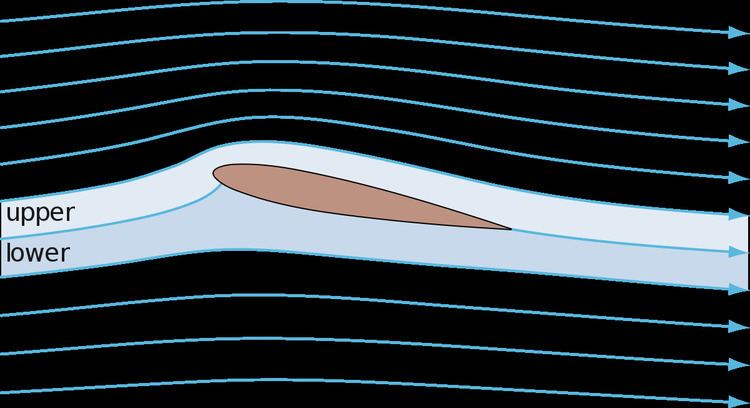 | ||
A foil is a solid object with a shape such that when placed in a moving fluid at a suitable angle of attack the lift (force generated perpendicular to the fluid flow) is substantially larger than the drag (force generated parallel the fluid flow). If the fluid is a gas, the foil is called an airfoil or aerofoil, and if the fluid is water the foil is called a hydrofoil.
Contents
Physics of foils
A foil generates lift primarily as a result of its shape and angle of attack. When oriented at a suitable angle, the foil deflects the oncoming fluid, resulting in a force on the foil in the direction opposite to the deflection. This force can be resolved into two components: lift and drag. This "turning" of the fluid in the vicinity of the foil creates curved streamlines which results in lower pressure on one side and higher pressure on the other. This pressure difference is accompanied by a velocity difference, via Bernoulli's principle, so the resulting flowfield about the foil has a higher average velocity on the upper surface than on the lower surface.
A more detailed description of the flowfield is given by the simplified Navier-Stokes equations, applicable when the fluid is incompressible. However, since the effects of the compressibility of air at low speeds is negligible, these simplified equations can be used for both airfoils and hydrofoils as long as the fluid flow is substantially less than the speed of sound (up to about Mach 0.3).
Basic design considerations
The degenerate case of a foil is a simple flat plate. When set at an angle (the angle of attack) to the flow the plate will deflect the fluid passing over and under it, and this deflection will result in a lift force on the plate. However, while it does generate lift, it also generates a large amount of drag.
Since even a simple flat plate can generate lift, a significant factor in foil design is the minimization of drag. An example of this is the rudder of a boat or aircraft. When designing a rudder a key design factor is the minimization of drag in its neutral position, which is balanced with the need to produce sufficient lift with which to turn the craft at a reasonable rate.
Other types of foils, both natural and man-made, seen both in air and water, have features that delay or control the onset of lift-induced drag, flow separation, and stall (see Bird flight, Fin, Airfoil, Placoid scale, Tubercle, Vortex generator, Canard (close-coupled), Blown flap, Leading edge slot, Leading edge slats), as well as Wingtip vortices (see Winglet).
